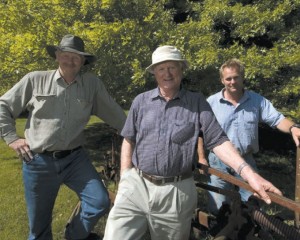You must be logged in to post a comment.
Archive
The Alexander name is synonymous with the picturesque settlement of Puketapu, beyond the hills of Taradale. The first of the Alexanders settled their farm here back in the 1920s, and the second generation, Roger, took over when he was twenty.
| Geoff & Cheryl | Puketapu |
|---|---|
| Type of operation | Sheep and Beef |
| Years of dicalcic use | 7 |
| Size of farm (effective) | 410ha |
| Average rainfall | 750ml |
| 2008 product used Hatuma No.9S @ 300kg/ha |
| Phil & Louise | Puketapu |
|---|---|
| Type of operation | Sheep and Beef |
| Years of dicalcic use | 5 |
| Size of farm (effective) | 420ha |
| Average rainfall | 750ml |
| 2007 product used | Hatuma No.8S @ 350kg/ha (no product applied in 2008) |
These days Roger’s sons, Phil and Geoff have returned to the 840ha property, consequently splitting it in half, and with their families are now managing either side as separate entities. That’s not to say they don’t work in with each other, quite the opposite. You’ll often find them lending one another a hand to assist with the day-to-day running, such as picking lambs, shearing, and docking. It’s a reflection of their shared farming philosophies and management style.
It was Roger who made the initial decision to start using Hatuma’s dicalcic on the property. He’d farmed through the 1980s with very little fertiliser, then through the tough times of the 1990s, he applied Hi Grow 767. Seven years ago they began looking for a product that would sweeten the soil and, with a bit of luck, improve the grazing. After making a visit to Hatuma Lime Company they decided to initially try a small amount of dicalcic across the farm at 200kg/ha. From there, Geoff and Phil have continued to use the dicalcic blends at 300kg/ha on their respective properties, although Phil admits he stopped for two years to apply capital rates of superphosphate. But after seeing how Geoff’s place continued to have a different appearance and was being grazed better, he’s since reverted back to the dicalcic blends.
‘When I took over I started re-grassing northerly hills,’ says Geoff ‘I had giant discs bouncing over the ratstail after it’d been sprayed with high rates of Roundup and it was so hard to break it down. We’d put it into rape for summer then regrass it for the autumn. It was a very time-consuming and expensive process.
Within a year of using dicalcic we started seeing a change. There were all these new plants germinating through the ratstail. We thought they must’ve been thistles, but two or three weeks later, we discovered they were clover plants. Where were they coming from? We couldn’t work it out. These days the ratstail has disappeared without re-grassing, without spraying, it’s died and gone, you can’t find it. Now our northerly faces are mainly clover and ryegrass. We’ve had droughts since, and the ones I spent time and money re-grassing have never responded again, they’re some of my worse paddocks now. The ones I’ve put just dicalcic on are the best by far. They’re steep paddocks too, you can’t get a tractor on them.’



 520 Maharakeke Rd, Waipukurau
520 Maharakeke Rd, Waipukurau

 0800 80 65 65 /
06 858 8567
0800 80 65 65 /
06 858 8567 06 8588018
06 8588018
Leave a Reply